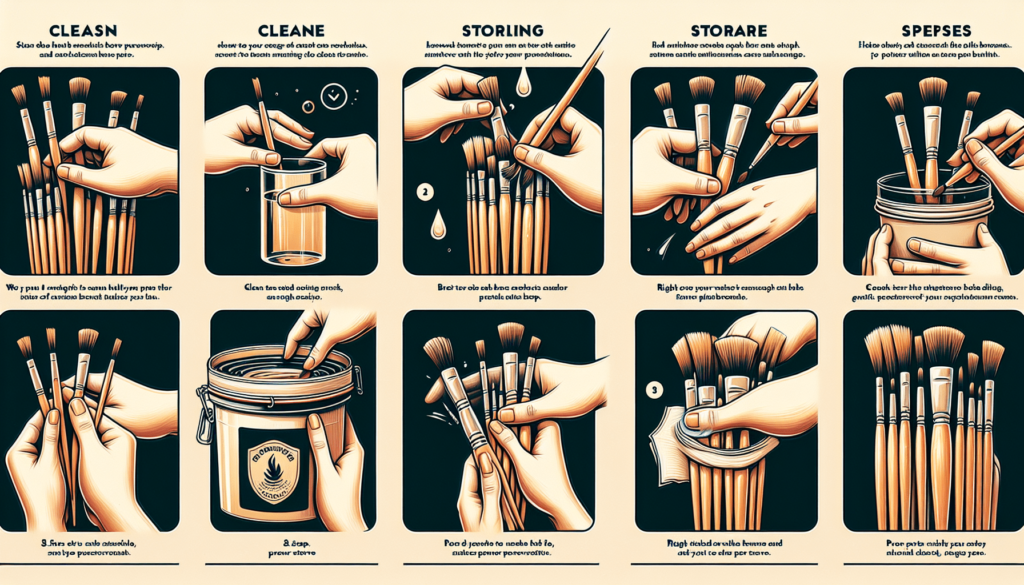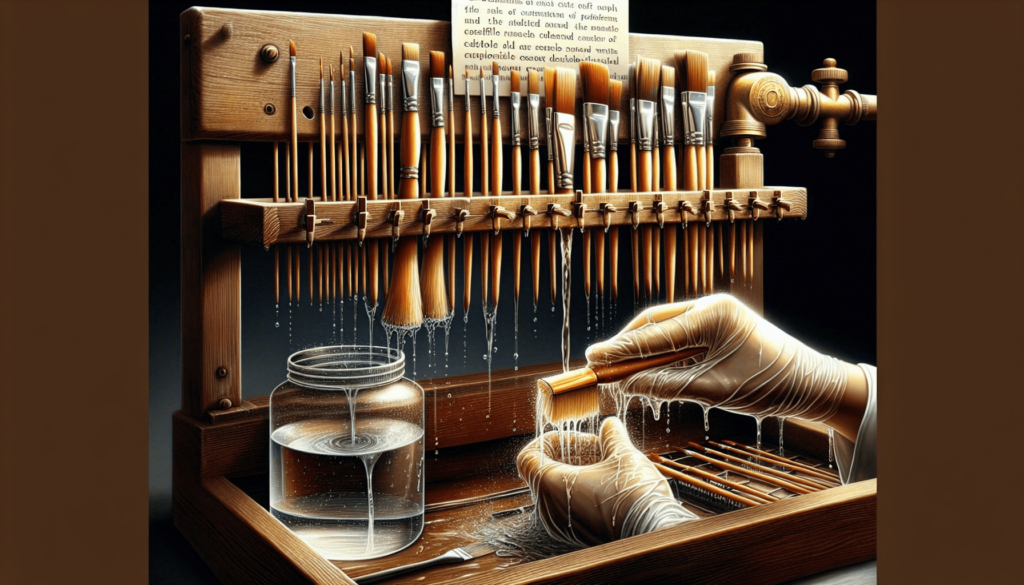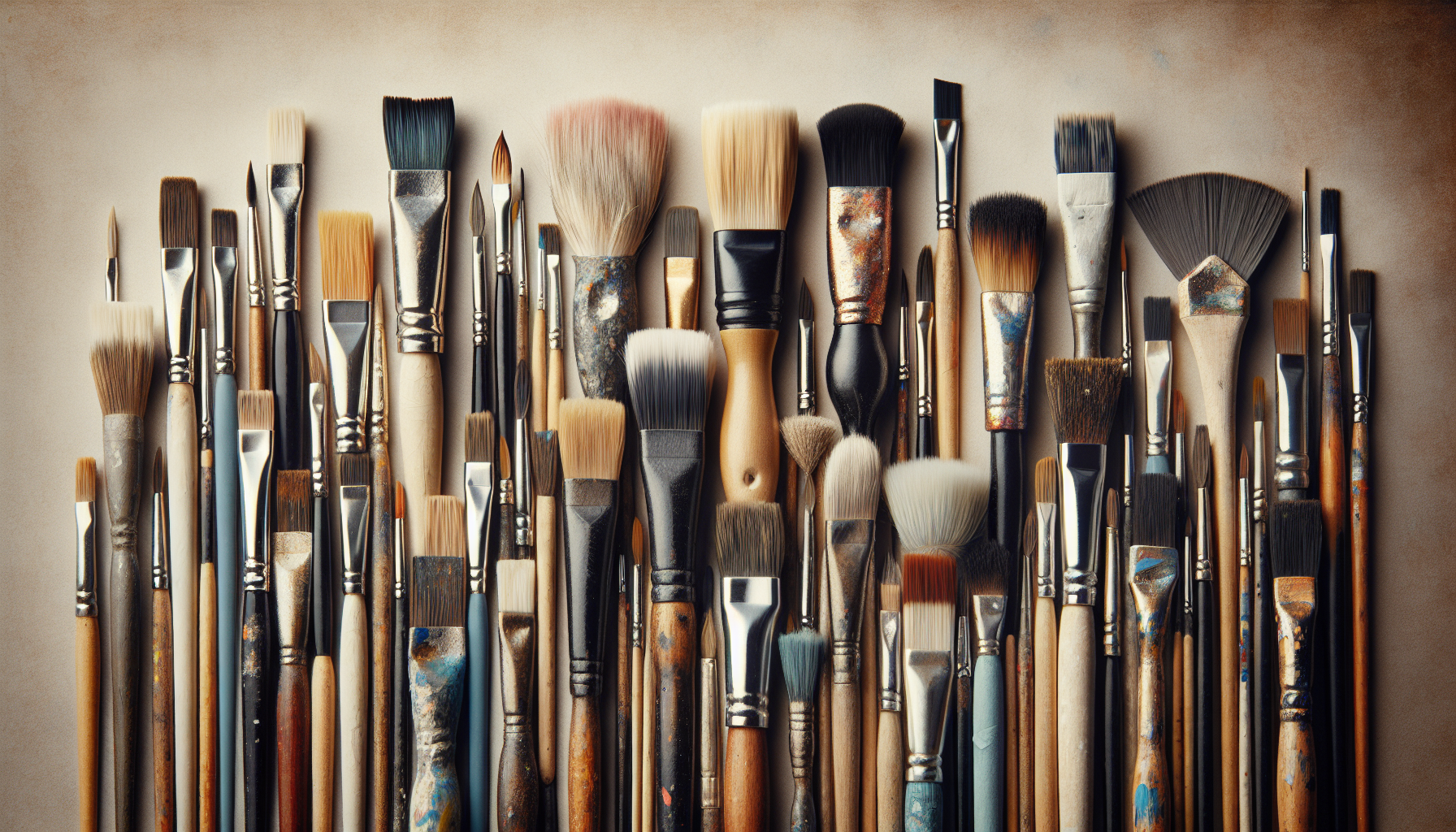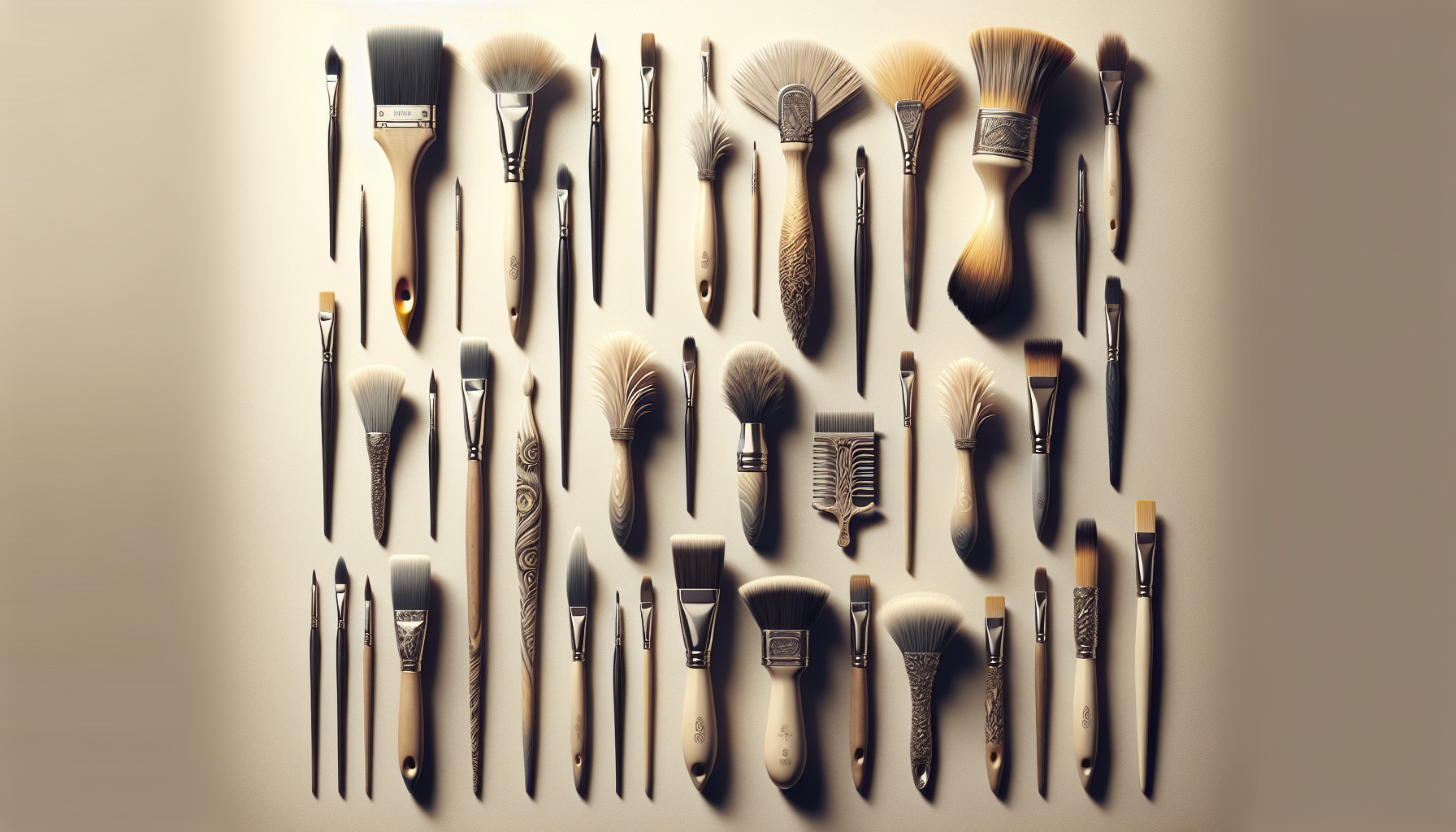Preserving the longevity and quality of your paint brush is essential in ensuring optimal performance and lasting results in your artwork. In this article, you will discover effective techniques and tips on how to properly care for and preserve your paint brush. By following these simple steps, you will be able to extend the life of your paint brush, maintain its shape, and prevent hardened bristles, ultimately enhancing your artistic process and achieving professional-grade artwork.
Cleaning the Paint Brush
Remove Excess Paint
Before cleaning your paint brush, it is important to remove any excess paint. You can do this by gently tapping the brush against the edge of your paint can or a disposable surface, such as a paper towel or old newspaper. By removing the excess paint, you will make the cleaning process much easier and more effective.
Rinse with Warm Water
After removing the excess paint, rinse your paint brush with warm water. Hold the brush under the faucet or use a container filled with warm water to thoroughly rinse the bristles. Gently swish the brush in the water to ensure that all remaining paint is removed. Be sure to use warm water, as hot water can damage the bristles and cold water may not effectively dissolve the paint.
Use Mild Soap or Paint Brush Cleaner
Once you have rinsed the paint brush, it is time to clean it using a mild soap or paint brush cleaner. Apply a small amount of the soap or cleaner to the bristles and gently massage it into the brush. Make sure to work the soap or cleaner throughout the entire brush, paying special attention to the base of the bristles where paint can easily accumulate. Rinse the brush thoroughly with warm water to remove all traces of soap and paint.
Removing Paint Residue
Soaking in Vinegar Solution
If there is still stubborn paint residue on your brush, you can try soaking it in a vinegar solution. Create a mixture of equal parts vinegar and warm water in a container large enough to hold the brush. Place the brush in the solution and let it soak for several hours or overnight. The acidity of the vinegar helps to break down the paint, making it easier to remove. After soaking, rinse the brush with warm water and proceed with the cleaning process.
Using Fabric Softener
Another effective method for removing paint residue is to use fabric softener. Fill a container with warm water and add a small amount of fabric softener. Mix the solution well and place your paintbrush in it, ensuring that the bristles are completely submerged. Let the brush soak for a few hours, allowing the fabric softener to soften and lift the paint. Once the paint has loosened, rinse the brush thoroughly with warm water.
Utilize Denatured Alcohol
If the previous methods do not fully remove the paint residue, you can try utilizing denatured alcohol. Moisten a clean cloth or paper towel with denatured alcohol and gently rub the bristles of the paint brush. The alcohol will help dissolve the paint and make it easier to remove. Be cautious when using denatured alcohol, as it is flammable. Make sure to work in a well-ventilated area and avoid open flames or sparks.

Drying the Paint Brush
Gently Squeeze Out Excess Water
Once you have thoroughly cleaned your paint brush, it is important to properly dry it to prevent damage and maintain its shape. Start by gently squeezing out any excess water from the bristles. Hold the brush firmly at the base of the bristles and lightly squeeze from the base towards the tip. Avoid applying excessive force, as this can misshape or damage the bristles.
Reshape the Bristles
After squeezing out the excess water, take a moment to reshape the bristles of your paint brush. Use your fingers to gently comb through the bristles, smoothing out any tangles or uneven spots. This will help the brush maintain its desired shape as it dries. Be careful not to pull or tug on the bristles too forcefully, as this can cause damage.
Air Dry Upside Down
To ensure that your paint brush dries properly and maintains its shape, it is recommended to air dry it upside down. Hang the brush or place it in a brush holder with the bristles facing downward. This will allow any remaining water to drip away from the base of the bristles, preventing water from pooling and potentially damaging the brush handle or ferrule.
Storing the Paint Brush
Wrap in Wax Paper or Plastic Wrap
When you are finished cleaning and drying your paint brush, it is essential to store it properly to maintain its condition. One effective way to protect the bristles is to wrap them in wax paper or plastic wrap. Start from the base of the bristles and tightly wrap the paper or plastic around the bristles, working your way towards the tip. This will prevent the bristles from getting bent or damaged while stored.
Use a Brush Holder or Sleeve
Another option for storing your paint brush is to use a brush holder or sleeve. These holders are designed specifically for paint brushes and provide a safe and convenient storage solution. Simply slide your brush into the holder or sleeve and secure it in place. Make sure to choose a holder or sleeve that is appropriate for the size of your brush to ensure a snug fit.
Keep in a Dry Place
It is crucial to store your paint brushes in a dry place to prevent mold or mildew growth and preserve the integrity of the bristles. Avoid storing your paint brushes in areas with high humidity, such as basements or bathrooms. Instead, choose a clean and dry space, such as a dedicated brush storage box or a well-ventilated cabinet. By keeping your brushes in a dry environment, you will prolong their lifespan and maintain their performance.

Preventing Bristle Damage
Avoid Storing Brush with Pressure on Bristles
To prevent damage to the bristles of your paint brush, it is important to store it correctly. Avoid storing the brush with any pressure or weight on the bristles, as this can cause them to bend or lose their shape. Opt for storing the brush in a way that allows the bristles to rest naturally without any external force. This will help preserve the quality and integrity of the bristles over time.
Keep Away from Extreme Temperatures
Exposing your paint brushes to extreme temperatures can have a detrimental impact on their durability. Avoid storing them in areas that are extremely hot or cold, such as near heaters or in freezing environments. Drastic temperature changes can cause the bristles to expand or contract, potentially leading to warping or breakage. Instead, store your paint brushes in a location with stable and moderate temperatures.
Protect the Brush Head
While working with paint, it is crucial to protect the brush head from excessive paint buildup or drying. To minimize the risk of damage, regularly wipe excess paint off the brush head during painting sessions. Utilize a clean cloth or paper towel to gently remove any excess paint from the bristles. By consistently maintaining the cleanliness of the brush head, you will prevent hardened paint from accumulating and potentially damaging the bristles.
Reviving Dried Paint Brushes
Soaking in Hot Vinegar or Fabric Softener
If you have neglected to clean your paint brush after use and it has dried with paint stuck to it, there are ways to revive it. One method is to soak the dried paint brush in a mixture of hot vinegar or fabric softener. Fill a container with either hot vinegar or a mixture of hot water and fabric softener. Submerge the brush and let it soak for several hours or overnight. The heat and acidity of the vinegar or fabric softener will help soften the dried paint, making it easier to remove.
Using Liquid Dish Soap
Liquid dish soap can also be effective in reviving dried paint brushes. Fill a container with warm water and add a few drops of liquid dish soap. Place the dried paint brush in the soapy water and let it soak for a few hours. The soap will break down the dried paint and loosen its grip on the bristles. After soaking, rinse the brush thoroughly with warm water and proceed with the cleaning process outlined earlier.
Brush Restorer Solution
For severely dried and stiff paint brushes, a brush restorer solution can be used to revive them. These solutions are specifically formulated to break down dried paint and restore the flexibility of the bristles. Follow the instructions provided with the brush restorer solution, as different products may have specific guidelines for use. Generally, the solution is applied to the dried brush and left to soak for a specified amount of time. After soaking, thoroughly rinse the brush with warm water to remove any remaining paint or cleaning solution.
Avoiding Common Mistakes
Leaving Brushes in Water for Extended Periods
Leaving paint brushes submerged in water for extended periods can cause serious damage to the bristles. The excessive moisture can weaken the glue holding the bristles together, as well as promote the growth of mold or mildew. Avoid this mistake by always removing your paint brush from water immediately after use. Clean and dry it promptly to prevent any potential damage.
Using Harsh Cleaners on Natural Bristles
Natural bristle brushes, such as those made from animal hair, require special care. Avoid using harsh cleaners or solvents on these brushes, as they can damage the delicate bristles. Harsh cleaners can strip the natural oils from the bristles, causing them to become dry and brittle. Stick to mild soaps or brush cleaners specifically designed for natural bristle brushes to ensure their longevity and performance.
Storing Wet Brushes in a Closed Container
Storing wet paint brushes in a closed container can create a damp and humid environment, which can lead to mold or mildew growth. If you need to temporarily store a wet brush during a painting session, make sure to use an open container or hang the brush to allow for proper air circulation. Once you have finished painting, thoroughly clean and dry the brush before storing it properly to prevent any potential damage.
Tips to Extend the Lifespan of Paint Brushes
Use Proper Brush Technique
Using proper brush technique can greatly extend the lifespan of your paint brushes. Avoid applying excessive pressure or scrubbing vigorously with the brush, as this can cause the bristles to become misshapen or worn out. Instead, use light and controlled strokes, allowing the bristles to gently glide over the surface. By using the brush correctly, you will minimize wear and tear on the bristles and maximize their lifespan.
Clean Brushes Immediately after Use
One of the most important tips for preserving your paint brushes is to clean them immediately after use. Leaving paint to dry on the bristles will make the cleaning process much more difficult and can cause permanent damage to the brush. Make it a habit to thoroughly rinse and clean your brushes as soon as you are finished using them. This will prevent paint from drying on the bristles and ensure that they remain in good condition for future use.
Store Brushes in a Lying Position
When storing your paint brushes, it is best to lay them flat rather than standing them upright. Storing brushes in a lying position allows the bristles to maintain their natural shape and prevents them from bending or becoming distorted. Additionally, this method helps to evenly distribute any remaining moisture, allowing the brush to dry more efficiently. Consider using a dedicated brush storage tray or a shallow box lined with a soft material to store your brushes lying flat.
Choosing the Right Paint Brush for the Job
Consider the Type of Paint
When selecting a paint brush for a specific project, it is important to consider the type of paint you will be using. Different paints require different bristle materials and brush sizes for optimal application. For example, natural bristle brushes are ideal for oil-based paints, while synthetic bristle brushes work well with water-based paints. Take into account the compatibility of the paint and brush to achieve the best results.
Evaluate the Surface
The surface you will be painting on also plays a role in choosing the right paint brush. Smooth surfaces, such as walls or furniture, typically require brushes with softer bristles, as they provide a smoother finish. On the other hand, textured surfaces, like stucco or rough wood, may require brushes with firmer bristles to effectively paint into the crevices. Evaluating the surface beforehand will help you determine the appropriate brush type.
Select the Appropriate Bristle Material
The bristle material is another important factor to consider when choosing a paint brush. Bristles can be made from natural materials, such as animal hair, or synthetic materials, such as nylon or polyester. Natural bristle brushes are typically used for oil-based paints, while synthetic bristle brushes are suitable for water-based paints. Synthetic bristles are also more resistant to wear and can maintain their shape better than natural bristles. Consider the paint type and the desired finish to make an informed decision about the bristle material.
Regular Maintenance and Care
Inspect Brushes for Damage
Regularly inspecting your paint brushes for any signs of damage is crucial for their preservation. Check the bristles for any fraying, splitting, or dried paint buildup. Pay attention to the ferrule (the metal band that holds the bristles) and handle as well, ensuring that they are intact and free from any cracks or loose parts. By catching any damage early on, you can take immediate action to prevent further deterioration.
Replace Worn Brushes
If you notice that your paint brushes are severely worn or damaged, it may be time to replace them. Worn brushes can affect the quality of your painting, as they may not distribute paint evenly or hold their shape properly. Additionally, if bristles have become stiff or distorted, it can be difficult to achieve precise and smooth brushstrokes. Invest in high-quality brushes and be prepared to replace them when they show signs of excessive wear.
Properly Dispose of Old Brushes
When it is time to replace your old paint brushes, it is important to dispose of them properly. Do not simply throw them in the regular trash, as the bristles can pose a hazard to waste handlers. Instead, check with your local recycling or hazardous waste facilities to see if they accept old paint brushes. Some facilities may have specific guidelines for disposal or recycling of paint brushes, so be sure to follow their instructions to ensure safe and environmentally-friendly disposal.
In conclusion, preserving the lifespan and maintaining the performance of your paint brushes requires proper cleaning, drying, storage, and general maintenance. By following the outlined techniques and tips, you can ensure that your paint brushes remain in optimal condition, allowing you to achieve professional results in your painting projects. Remember to choose the appropriate brush for each job, promptly clean your brushes after use, and store them in a dry and safe environment. With regular care and attention, your paint brushes can provide you with many successful painting experiences.



